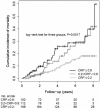Iron, inflammation, and early death in adults with sickle cell disease
- PMID: 25378535
- PMCID: PMC4297524
- DOI: 10.1161/CIRCRESAHA.116.304577
Iron, inflammation, and early death in adults with sickle cell disease
Abstract
Rationale: Patients with sickle cell disease (SCD) have markers of chronic inflammation, but the mechanism of inflammation and its relevance to patient survival are unknown.
Objective: To assess the relationship between iron, inflammation, and early death in SCD.
Methods and results: Using peripheral blood mononuclear cell transcriptome profile hierarchical clustering, we classified 24 patients and 10 controls in clusters with significantly different expression of genes known to be regulated by iron. Subsequent gene set enrichment analysis showed that many genes associated with the high iron cluster were involved in the toll-like receptor system (TLR4, TLR7, and TLR8) and inflammasome complex pathway (NLRP3, NLRC4, and CASP1). Quantitative PCR confirmed this classification and showed that ferritin light chain, TLR4, and interleukin-6 expression were >100-fold higher in patients than in controls (P<0.001). Further linking intracellular iron and inflammation, 14 SCD patients with a ferroportin Q248H variant that causes intracellular iron accumulation had significantly higher levels of interleukin-6 and C-reactive protein compared with 14 matched SCD patients with the wild-type allele (P<0.05). Finally, in a cohort of 412 patients followed for a median period of 47 months (interquartile range, 24-82), C-reactive protein was strongly and independently associated with early death (hazard ratio, 3.0; 95% confidence interval, 1.7-5.2; P<0.001).
Conclusions: Gene expression markers of high intracellular iron in patients with SCD are associated with markers of inflammation and mortality. The results support a model in which intracellular iron promotes inflammatory pathways, such as the TLR system and the inflammasome, identifying important new pathways for additional investigation.
Keywords: gene expression; inflammation; iron; mortality; sickle cell disease.
© 2014 American Heart Association, Inc.
Figures




References
-
- Torti FM, Torti SV. Regulation of ferritin genes and protein. Blood. 2002;99:3505–16. - PubMed
-
- Gordeuk VR, Ballou S, Lozanski G, Brittenham GM. Decreased concentrations of tumor necrosis factor-alpha in supernatants of monocytes from homozygotes for hereditary hemochromatosis. Blood. 1992;79:1855–60. - PubMed
-
- Tsukamoto H, Lin M, Ohata M, Giulivi C, French SW, Brittenham G. Iron primes hepatic macrophages for NF-kappaB activation in alcoholic liver injury. Am J Physiol. 1999;277:G1240–1250. - PubMed
Publication types
MeSH terms
Substances
Grants and funding
LinkOut - more resources
Full Text Sources
Other Literature Sources
Medical
Molecular Biology Databases
Research Materials
Miscellaneous

